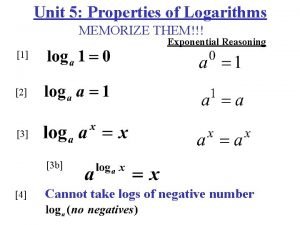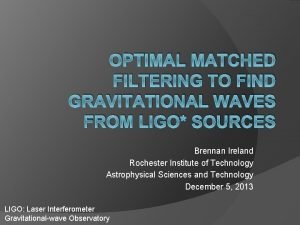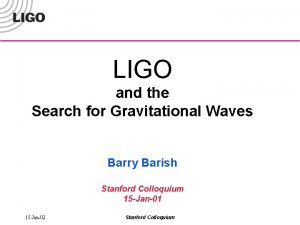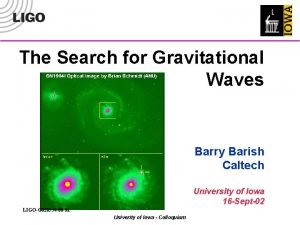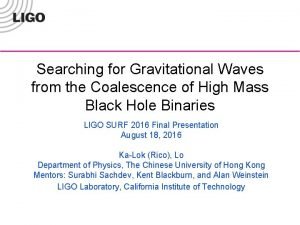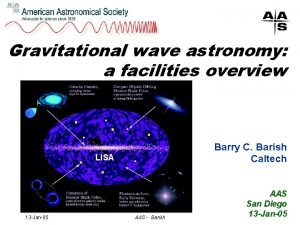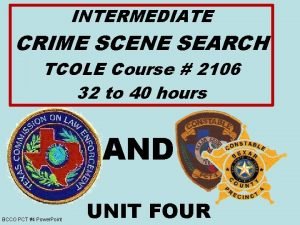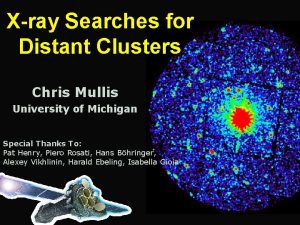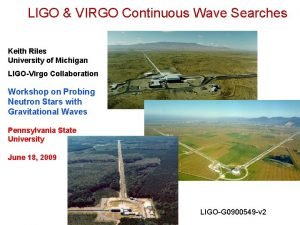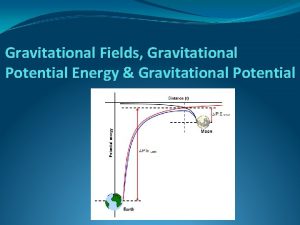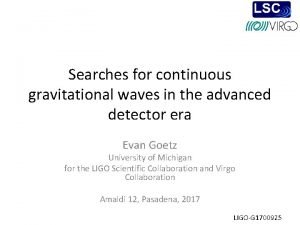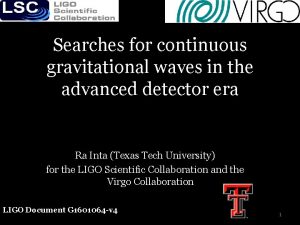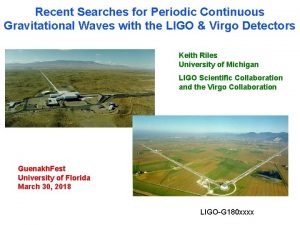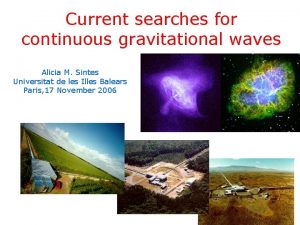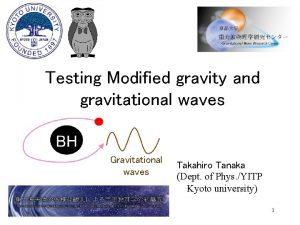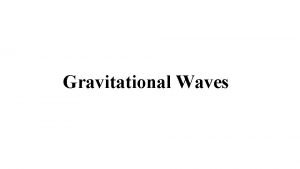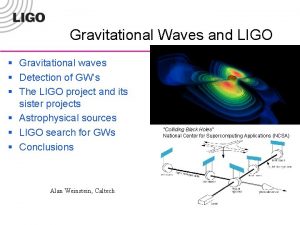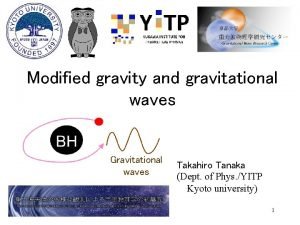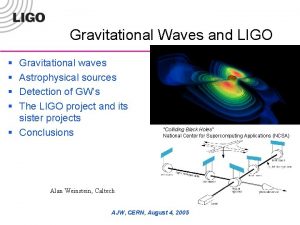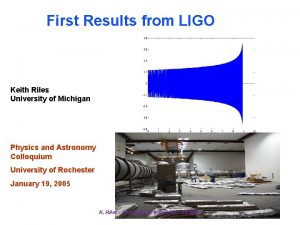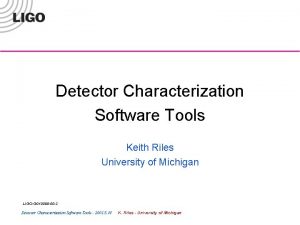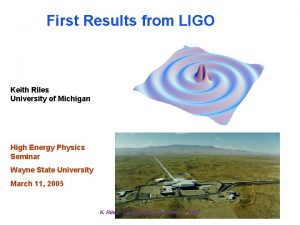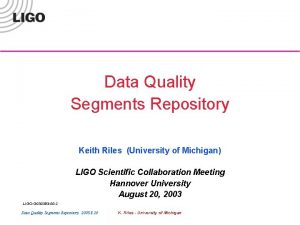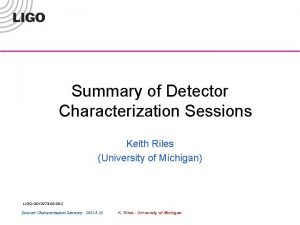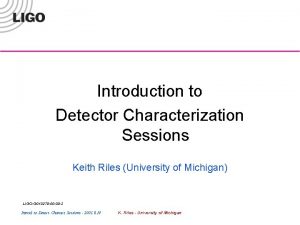Searches for Continuous Gravitational Waves Keith Riles University


























- Slides: 26

Searches for Continuous Gravitational Waves Keith Riles University of Michigan LIGO Scientific Collaboration and the Virgo Collaboration Guenakh Fest University of Florida March 30, 2018 LIGO-G 1800421

Generation of Continuous Gravitational Waves q Radiation generated by quadrupolar mass movements: No GW from axisymmetric object rotating about symmetry axis (Iμν = quadrupole tensor, r = source distance) q Spinning neutron star with equatorial ellipticity εequat gives a strain amplitude h (f. GW = 2 f. Rot): Courtesy: U. Liverpool 2

Gravitational CW mechanisms q Equatorial ellipticity (e. g. , – mm-high “bulge”): q Poloidal ellipticity (natural) + wobble angle (precessing star): (precession due to different L and Ω axes) q Two-component (crust+superfluid) q r modes (rotational oscillations – CFS-driven instability): N. Andersson, Ap. J 502 (1998) 708 S. Chandrasekhar PRL 24 (1970) 611 J. Friedman, B. F. Schutz, Ap. J 221 (1978) 937 3

Gravitational CW mechanisms Assumption we (LSC, Virgo) have usually made to date: Bulge is best bet for detection Look for GW emission at twice the EM frequency e. g. , look for Crab Pulsar (29. 7 Hz) at 59. 5 Hz (troublesome frequency in North America!) What is allowed for εequat ? Old maximum (? ) ≈ 5 × 10 -7 [σ/10 -2] (“ordinary” neutron star) with σ = breaking strain of crust G. Ushomirsky, C. Cutler, L. Bildsten MNRAS 319 (2000) 902 More recent finding: σ ≈ 10 -1 supported by detailed numerical simulation C. J. Horowitz & K. Kadau PRL 102, (2009) 191102 Recent re-evaluation: εequat < 10 -5 N. K. Johnson-Mc. Daniel & B. J. Owen PRD 88 (2013) 044004 4

Gravitational CW mechanisms Strange quark stars could support much higher ellipticities B. J. Owen PRL 95 (2005) 211101, Johnson-Mc. Daniel & Owen (2013) Maximum εequat ≈ 10 -1 (!) But what εequat is realistic? What could drive εequat to a high value (besides accretion)? Millisecond pulsars have spindown-implied values lower than 10 -9– 10 -6 5

Finding a completely unknown CW Source Serious technical difficulty: Doppler frequency shifts w Frequency modulation from earth’s rotation (v/c ~ 10 -6) w Frequency modulation from earth’s orbital motion (v/c ~ 10 -4) Coherent integration of 1 year gives frequency resolution of 30 n. Hz 1 k. Hz source spread over 6 million bins in ordinary FFT! Additional, related complications: Daily amplitude modulation of antenna pattern Spin-down of source Orbital motion of sources in binary systems 6

Finding a completely unknown CW Source Modulations / drifts complicate analysis enormously: w Simple Fourier transform inadequate w Every sky direction requires different demodulation Computational scaling: Single coherence time – Sensitivity improves as (Tcoherence)1/2 but cost scales with ~ (Tcoherence)6+ Restricts Tcoherence < few days for all-sky search Exploit coincidence among different spans Alternative: Semi-coherent stacking of spectra (e. g. , Tcoherence = 30 min) Sensitivity improves only as (Nstack)1/4 All-sky survey at full sensitivity = Formidable challenge Impossible? 7

But three substantial benefits from modulations: w Reality of signal confirmed by need for corrections w Corrections give precise direction of source w Single interferometer can make definitive discovery Can “zoom in” further with follow-up algorithms once we lock on to source V. Dergachev, PRD 85 (2012) 062003 M. Shaltev & R. Prix, PRD 87 (2013) 084057 A. Singh et al, PRD 96 (2017) 082003 Sky map of strain power for signal injection (semi -coherent search) 8

Recent results B. Abbott et al. , Ap. J. . 839 (2017) 12 Targeted search for 200 known pulsars in O 1 data Lowest (best) upper limit on strain: h 0 < 1. 6 × 10− 26 Lowest (best) upper limit on ellipticity: ε < 1. 3 × 10 -8 Crab limit at 0. 2% of total energy loss (beats “spindown limit”) 9 ar. Xiv: 1309. 4027 (Sept 2013)

Another take on the 200 * 10 *Also looked for non-tensorial polarizations – none seen – B. Abbott et al, PRL 120 (2018) 031104

Recent results – Narrowband Search Targeted search assumes exact agreement between EM and GW phase, but differential rotation can lead to slight mismatch Additional search (“narrowband”) for nearby phase templates – O(10 -3) relative frequency mismatch Can still beat spindown limit for handful of pulsars B. Abbott et al. , PRD 96, 122006 (2017) 11

Recent results – Scorpius X-1 Low-mass X-ray binary (LMXB) – brightest X-ray source outside Sun For an LMXB, equating accretion rate torque (inferred from X-ray luminosity) to gravitational wave angular momentum loss (steady state) gives: [R. V. Wagoner, Ap. J 278 (1984) 345; J. Papaloizou & J. E. Pringle, MNRAS 184 (1978) 501; L. Bildsten, Ap. J 501 (1998) L 89] Courtesy: Mc. Gill U. 12 B. Abbott et al. , PRD 96, 122006 (2017)

Recent results – All-sky search B. Abbott et al. , ar. Xiv: 1802. 05241, Feb 2018 13

Recent results – All-sky search B. Abbott et al. , PRD 96, 062002 (2017) Lower frequency band badly contaminated with instrumental spectral lines 14

Recent results – All-sky search B. Abbott et al. , PRD 96, 122004 (2017) Einstein@Home permits deepest search at lowest frequencies 15

Summary No CW discoveries yet, but… • Still examining data we have taken in O 2 run Future: • More sensitive detectors • Longer (and cleaner) data sets • Improved algorithms Could be on cusp of new type of GW discovery Nature sometimes bestows golden gifts… 16

Extra Slides 17

Recent results – All-sky search B. Abbott et al. , ar. Xiv: 1802. 05241, Feb 2018 18

What is the “direct spindown limit”? It is useful to define the “direct spindown limit” for a known pulsar, under the assumption that it is a “gravitar”, i. e. , a star spinning down due to gravitational wave energy loss Unrealistic for known stars, but serves as a useful benchmark Equating “measured” rotational energy loss (from measured period increase and reasonable moment of inertia) to GW emission gives: Example: Crab h. SD = 1. 4 × 10 -24 (d=2 kpc, f. GW = 59. 5 Hz, df. GW/dt = − 7. 4× 10 -10 Hz/s ) 19

What is the “age-based spindown limit”? If a star’s age is known (e. g. , historical SNR), but its spin is unknown, one can still define an indirect spindown upper limit by assuming gravitar behavior has dominated its lifetime: And substitute into h. SD to obtain [K. Wette, B. Owen, … CQG 25 (2008) 235011] Example: Cassiopeia A h. ISD = 1. 2 × 10 -24 (d=3. 4 kpc, τ=328 yr) 20

What is the “X-ray flux limit”? For an LMXB, equating accretion rate torque (inferred from X-ray luminosity) to gravitational wave angular momentum loss (steady state) gives: [R. V. Wagoner Ap. J 278 (1984) 345; J. Papaloizou & J. E. Pringle MNRAS 184 (1978) 501; L. Bildsten Ap. J 501 (1998) L 89] Example: Scorpius X-1 h. X-ray ≈ 3 × 10 -26 [600 Hz / fsig]1/2 (Fx= 2. 5 × 10 -7 erg·cm-2·s-1) Courtesy: Mc. Gill U. 21

Other results Not all known sources have measured timing Compact central object in the Cassiopeia A supernova remnant Birth observed in 1681 – One of the youngest neutron stars known Star is observed in X-rays, but no pulsations observed Requires a broad band search over accessible band 22 Cassiopeia A

Other results – Directed search Search for Cassiopeia A – Young age (~300 years) requires search over 2 nd derivative S. J. Zhu et al. , PRD 94 (2016) 082008 23 indirect upper limit (based on age, distance)

Other results – All-sky binary search J. Aasi et al. , PRD 90 (2014) 062010 24

Searching for continuous waves Frequency bin Several approaches tried or in development: • Summed powers from many short (30 -minute) FFTs with skydependent corrections for Doppler frequency shifts “Semicoherent “ • (Stack. Slide, Hough transform (2 types), Power. Flux) Time • Push up close to longest coherence time allowed by computing resources (~few days) and look for coincidences among outliers 25 in different data stretches (demodulation-based F-Statistic)

http: //www. einsteinathome. org/ q q q q GEO-600 Hannover LIGO Hanford LIGO Livingston Current search point Current search coordinates Known pulsars Known supernovae remnants Your computer can help too! 26
 Logm^n
Logm^n Riles building nau
Riles building nau Matched filtering gravitational waves
Matched filtering gravitational waves Gravitational waves
Gravitational waves Gravitational waves
Gravitational waves Gravitational waves
Gravitational waves Gravitational waves
Gravitational waves 2711 se loop 410 south
2711 se loop 410 south Xray searches
Xray searches Similarities of mechanical and electromagnetic waves
Similarities of mechanical and electromagnetic waves Light is an electromagnetic wave true or false
Light is an electromagnetic wave true or false Examples of mechanical waves
Examples of mechanical waves Mechanical and electromagnetic waves similarities
Mechanical and electromagnetic waves similarities The wave chapter 13
The wave chapter 13 Sound waves longitudinal waves
Sound waves longitudinal waves What is a semiconductor used for
What is a semiconductor used for Difference between matter waves and electromagnetic waves
Difference between matter waves and electromagnetic waves Mechanical vs electromagnetic waves
Mechanical vs electromagnetic waves Similarities of mechanical and electromagnetic waves
Similarities of mechanical and electromagnetic waves Surface waves and body waves
Surface waves and body waves Seismic waves are mechanical waves
Seismic waves are mechanical waves Compare and contrast p waves and s waves using venn diagram
Compare and contrast p waves and s waves using venn diagram What do all waves transmit
What do all waves transmit Difference between constructive and destructive waves
Difference between constructive and destructive waves Present past and future continuous tense
Present past and future continuous tense Present simple past simple future simple present continuous
Present simple past simple future simple present continuous Kontinuitetshantering i praktiken
Kontinuitetshantering i praktiken
